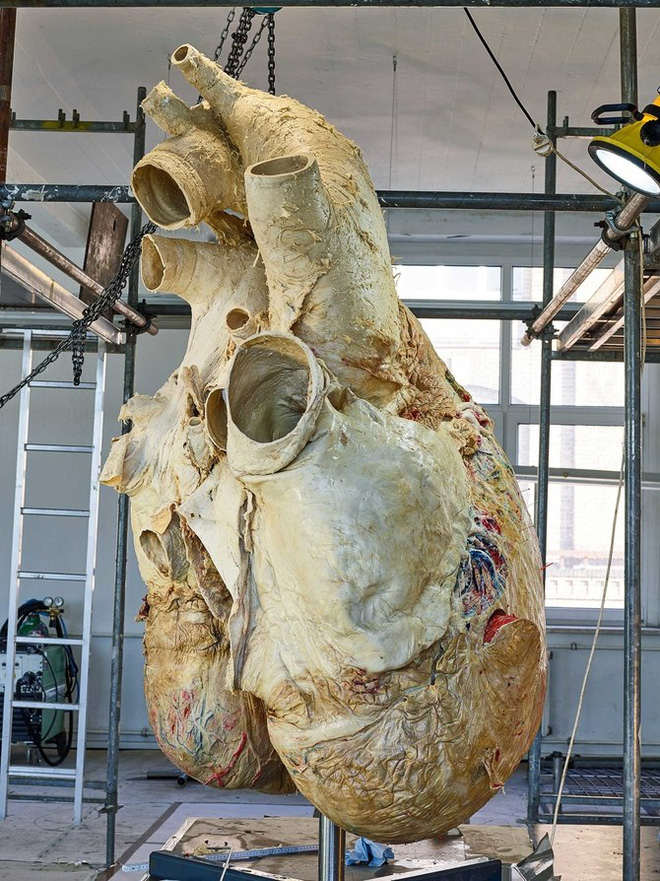The process of turning 200kg whale hearts into 'plastic hearts' is not decomposed
Last May, the world's largest 200kg heart whale was first displayed at the Royal Ontari Museum in Toronto for public viewing. This giant heart belongs to the blue whale who died aground in Canada in 2014.
- Why do humpback whales prevent killer whales from hunting other animals?
- Why can whale carcass explode?

When a whale dies, it will become a giant food block for fish and seabirds outside the ocean. If the whale's body washed ashore, it would rot and there was a risk of explosion at any time.
The rate of whale decomposition is very fast, mammalian researchers at the Ontario Royal Museum in Toronto were fortunate to meet the body of a blue whale that washed ashore still in good enough condition.
According to experts, thanks to processing technology, preservation called plastination, the heart of this blue whale will remain intact and not stink for decades to come.
Jaqueline Miller, who leads the heart preservation team, revealed this special preservation process.
Here are 4 stages in the process of preserving the world's largest heart of the blue whale:

1. The process of taking the heart out of the whale's body
It took 10 workers to use an iron hook to pull the whale's flesh, to divide it into small pieces of meat. Starting from the tail, when the surgery reaches the heart, the vascular surgeons lead into the heart, then they open the chest and push the heart out.
During this process, the team must work when the rotting flesh of the whale folds to the knees.
2. Make the heart bloom
The heart of the whale collapsed due to the absence of blood. So the researchers put the tap into two blood vessels, sealing the way out with plastic bottles. They then poured into the heart more than 2,600 liters of formaldehyde to harden the heart muscle, to prevent decomposition and inflate the heart to its original shape.

3. Transporting giant hearts
The giant heart is covered with 3 layers of water repellent, then a forklift is used to put the heart into a large steel container along with foam transport. The heart is transported by air to Gubener Plastinate, Germany.
4. Plastinate stage
The heart is immersed in a solution of acetone (acetone). During 6 months, the solution is changed continuously. During this time, acetone will replace water molecules in heart tissue.
After that, the process of 'plasticization' will be carried out. German surgeons will irrigate the silicon polymer heart, followed by a vacuum chamber. Here, the air pressure will drop almost like the universe, causing the acetone to fly away and be replaced by polymer molecules.
5. The process of turning whale heart into "plastic"
A gas used to harden silicon is present in the heart. After three months, the whale heart will become a giant "plastic" heart.
The process of plastination - "plasticizing" to preserve the giant whale heart is complete. It can be "resilient" in the museum for many years without fear of being affected by the hands of the handler who touches it.
You should read it
- Why can whale carcass explode?
- Super rare scene: Blue whales ... 'walk heavy' in the middle of the ocean
- Listed 10 largest species of creatures in the ocean
- Signs of heart disease should not be ignored
- Defeating the blue whale, this 37m-long dinosaur is the world's largest creature
- Top of the most beautiful heart images
- Scientific explanation of 'broken heart' when falling in love
- 15 most giant animals in the natural world
- 7 best heart rate monitor apps in 2020
- Configuration to play Atomic Heart on PC
- Instructions on how to measure heart rate at home
- Patching heart defects with new biological materials
May be interested

Looking back at 27 years of development of the Boeing 777 - the best aircraft in the world

Scientists confirm: People can go through, travel time

Why is the power line always sagging?

11 interesting things can be observed through looks

The mysterious island of a strange shape suddenly appears in Bermuda's 'Devil Triangle'

Continuous push of 1,500 is only one of 10 world records that no one has ever broken of Bruce






 Bioplastic biodegradable in natural environment made from shrimp shells
Bioplastic biodegradable in natural environment made from shrimp shells Why can whale carcass explode?
Why can whale carcass explode? Image of the 200kg iPhone, the largest in the world
Image of the 200kg iPhone, the largest in the world What is ABS plastic? Applications of ABS plastic in life
What is ABS plastic? Applications of ABS plastic in life Super rare scene: Blue whales ... 'walk heavy' in the middle of the ocean
Super rare scene: Blue whales ... 'walk heavy' in the middle of the ocean How dangerous chemicals are in plastic consumer products
How dangerous chemicals are in plastic consumer products